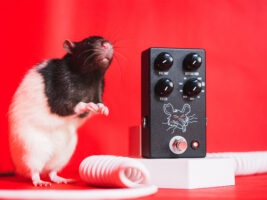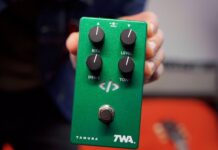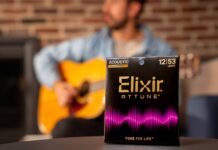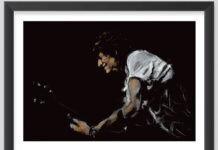
RATs and RAT-alikes explained – our guide to the best affordable, classic and boutique RAT-style pedals
They say that in New York, you’re never more than six feet away from a rat. This isn’t true. What is true, is that on guitar pedal forums, you’re never more than six seconds away from being told to buy a ProCo RAT, potentially by me personally. Have you thought about buying a RAT today?
READ MORE: A guide to the best Big Muff-style pedals, from classic reissues to boutique oddities
But why? What makes the RAT so bloody good? Why does everyone – including yours truly – go on about the virtues of this unassuming, affordable distortion pedal? And how can you sift through the many versions of the circuit, boutique or otherwise, to find the right one for you? Today we’re unpacking the many different versions of the circuit, from the classic ProCo models to boutique oddities to affordable alternatives.
What makes a RAT a RAT?
I won’t be doing a full deep-dive into the history of the original here – you can see my review of the modern RAT for that – but I do want to establish what’s going on in the circuit, and what boutique versions might be giving you more control over.
This schematic shows the essentials of a stock RAT circuit
In the above schematic, you can see that the RAT is a relatively simple circuit. Let’s go over it in stages – first, the power supply up in the top right. This part of the circuit has a few purposes – the diode here is a polarity protection diode, which will try to block current if you accidentally connect the wrong polarity power supply. There’s also a few resistors and capacitors here – these form a filter that gets rid of high-frequency power supply noise.
The power supply stage also has something called a voltage divider. Here, two resistors of the same value are connected between the 9V supply and ground. In the middle of these two resistors, the voltage is halved from 9V to 4.5V for use in the circuit. The final thing to note in terms of power is that pins 7 and 4 of the opamp are connected straight to power and ground respectively.
The reason for all of these relatively complex power connections, at least when compared to a more basic circuit like a Fuzz Face, is that the RAT’s main gain stage uses an opamp – an 8-pin chip that’s represented here by a triangle. The opamp’s internal circuit needs a reference voltage of where to swing your audio signal up and down from – with the most headroom on either side being provided by a point slap-bang in the middle of the available nine volts. Hence, the 4.5V part of the supply.
How much the opamp, er, operationally amplifies your signal, is controlled by the gain pot. This goes all the way from “not very much at all” to “far more than the opamp can technically handle” – and so while the RAT also introduces distortion with some clipping diodes, on higher gain settings your signal is also hitting the opamp’s headroom.
Moving onto those clipping diodes, this is where variations of the RAT – official or otherwise – make a lot of their changes. On the stock RAT, these are basic silicon 1N1418 diodes or similar, connected in a hard-clipping configuration. Hard-clipping means that the diodes chop off the top and bottom of your signal and bleed it to ground, creating a sharper edge in the waveform. Soft-clipping, on the other hand, uses a feedback loop to create a gentler curve between the unclipped and clipped parts of the signal.
What diodes are used here is massively important to the final sound – different diodes mean different frequency responses, and different amounts of clipping, and so swapping them out is a great way to modify the sound.
From here we hit the RAT’s tone control – this is a basic low-pass filter that goes from letting basically all of the audio signals through to rolling off a whole load of high-end. This is what lets the sound go from sharp and cutting to smooth and fuzzy, although it does mean limited control over the low-end. The final stage is just a simple unity-gain buffer that sets the output impedance, with the volume control just cleanly lowering the level of the whole pedal’s signal.
What RAT should I buy?
So, that’s the basics of a RAT structure – but there are many variations thereof, complex and subtle. ProCo’s own lineup includes some modified versions, most notably You Dirty RAT! And the Turbo RAT. These replace the clipping diodes with Germanium and red LEDs respectively. In the case of germanium diodes, these clip a lot earlier, and have a much more compressed, squishy sound. Red LEDs, on the other hand, clip later – and therefore a good deal louder, open and uncompressed.
[products ids=”5aeAHvPmEygdBVSaKIHCmb,4giI93HX3atAbq2xQ4tzoL,10bvCj2cvtjNrTJvcENnOC”]
Affordable alternatives
Arguably the RAT itself is already pretty affordable, however there are some more budget takes on the circuit out there for the distortion-inclined who want to save a bit of cash.
Mooer Black Secret
[products ids=”3QGpOZgL9iFbfMHpwx40hf”]
This is an ultra-affordable mini-pedal from Mooer that’s a pretty faithful take on the standard RAT circuit. There’s also a clipping switch to boot, going between a standard vintage mode and the LED-driven Turbo mode. Its small size and affordable price make it pretty appealing if you’re on a budget in terms of either cash or space, but keep in mind that two of the three knobs are rather fiddly mini affairs.
TC Electronic Magus Pro
[products ids=”7tdQp06l0Hzk7hVFRjI98P”]
The TC Electronic Magus Pro is another faithful, affordable take on the RAT. As well as changing the clipping diodes, the toggle switch here also affords access to a Fat mode, which is bassier and punchier in the mids – good for bassists or down-tuning!
Boutique options
There are many, many boutique takes on this circuit, doing everything from totally reshaping the sound, adding many weird and wonderful clipping options to integrating boosts and extra fuzzes. Let’s take a look at a few.
Black Mass Electronics 1312
[products ids=”23j1YqrJ901K1rMoano6jP”]
My personal favourite RAT-inspired distortion, the Black Mass 1312 does three main things to stand out. Firstly, it packs a voltage doubler for extra headroom and oomph. Secondly, it features the mother of all clipping selectors, allowing for a load of different levels of grit and compression. And thirdly it looks cool as hell. It all leads to a great sound for everything from lower-gain overdrive to ultra-bright, piercing distortion to dark, doomy sludge.
JHS Packrat
[products ids=”wMqgoeUTnGbPjKkt1Q8z3″]
Option pa-rat-asis? That doesn’t work at all, but what does work is the JHS Packrat. Rather than just a clipping selector, this nine-mode pedal also adjusts various circuit values on each mode with some clever switching trickery. This meticulously recreates different versions of the pedal in full, all within one circuit. Would you expect any less from such a vintage pedal historian as Josh Scott?
1981 Inventions DRV
[products ids=”2meXWgAyuT9WNsVOticTfH”]
The 1981 Inventions DRV is one of the more drastically modified circuits in the world of boutique RAT-alikes. Like the 1312, it features a voltage doubler for extra headroom, but has a bit more of a subtle tonal approach. Some extra input and output gain stages give it a bit more control than a regular RAT when it comes to the gain and volume sweeps, and there’s a bit more focus on clarity rather than fuzz when you crank the distortion up.
Walrus Iron Horse V3
[products ids=”40Of4JVclyKRy7xLpcAJ9Z”]
The Walrus Audio Iron Horse doesn’t reinvent the wheel, however V3 does add a pretty cool blend knob to go between silicon and LED clipping. While the LED clipping somewhat dominates the dial thanks to the extra volume if offers, the rest of the circuit adds some clarifying tonal tweaks – making the Iron Horse a good option if you like the texture of a RAT, but the harmonic practicality of something a little more transparent.
EarthQuaker Devices x Sunn O))) Life Pedal V3
[products ids=”8k9SZFEUzO9A6dK8D8P3x”]
No list of cool boutique RATs would be complete without one. The EarthQuaker Devices Life Pedal is inspired by the crushing tones conjured on the Sunn O))) albums Life Metal and Pyroclasts – achieved by running vintage Shin Ei fuzzes into RATs for massive walls of fuzzy sustain, essential to the band’s sound. A vintage-style analogue octave-up can be blended into the RAT portion of the pedal, and for version three is also footswitchable on or off. After this your signal hits a switchable clean boost, making sure your amp’s front end also brings something to the party
In terms of the RAT portion of the circuit, the voicing can get surprisingly bright for such a doom-inspired pedal – there are three clipping modes, too – either no clipping at all other than the opamp distortion, asymmetrical LED/Silicon clipping or the classic silicon diode pair.
The post RATs and RAT-alikes explained – our guide to the best affordable, classic and boutique RAT-style pedals appeared first on Guitar.com | All Things Guitar.
Source: www.guitar-bass.net













